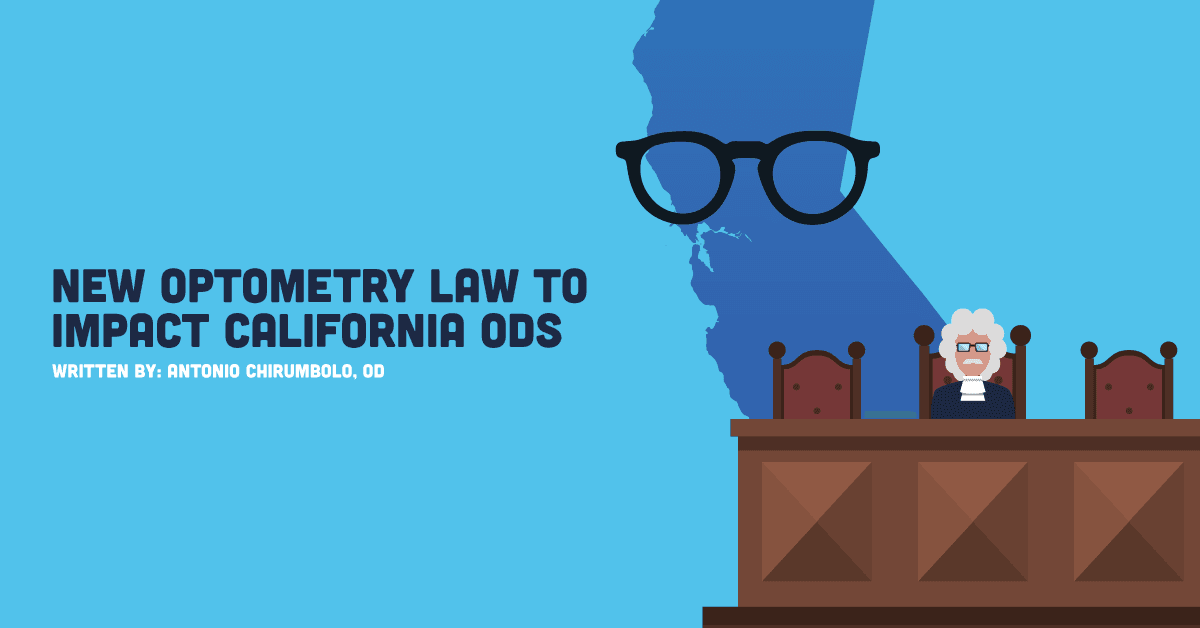In case you missed it, a new optometry law sponsored by the State Board of Optometry recently went into effect that impacts California optometrists.
Governor Jerry Brown signed SB 1386 into law, that went into effect January 1st, 2019. This bill was an act to amend Sections 3070 and 3077 of the Business and Professions Code, relating to professions and vocations.
What does this new optometry law mean for California ODs?
Here's a quick look at the previous law and the changes:
| Previous Law | Current Law | |
|---|---|---|
| Cap on # of offices | No cap. However, owners must spend 50% of their time working at each of their locations, effectively creating a two office maximum limit. | Cap set to 11 offices for any single OD (or two or more joint ODs working together). No working time requirement. |
| Registration requirement | ODs must pay a fee and obtain a branch office license for every location. | Still requires individual statements of licensure for each location, but it no longer requires a branch office license. |
| Compliance failure | Suspension of licensure | Suspension of licensure |
Why the limit of 11 office locations?
The decision to cap the number of locations at eleven (11) was done in the best interest of both patients and practicing ODs.
When evaluating the benefits of what was effectively a two location maximum, it was decided that the limitation provided no true benefit to consumers or patients. In fact, it was argued that this cap could limit access to care for patients in more rural areas. If there were ODs interested in opening additional offices in these locations, they would not be able to.
At the same time, however, it was argued that having no limitation on the number of practice locations an OD or group could own could be detrimental to patients. Without a cap, a group that wanted to open an extremely large number of offices could further contribute to the rapid corporatization of the industry.
Furthermore, setting a limit on locations helps ensure that owners can remain privy to all of the licensed activities occurring in their practices. It is easy to imagine how quickly a business owner with 50 locations, for example, could begin to lose track of the way each office operates. Having a limitation helps ensure these owners remain accountable for providing a high level of care across all of their businesses.
The role of the California Optometric Association
Throughout the construction of SB 1386, the COA fought to secure several amendments to this new optometry law enacted by SB 1386, including the eleven practice limit, while protecting ODs from increased scrutiny and disciplinary actions.
Amendments that the COA ensured:
- There is an eleven (11) location limit
- Optometrists do not need to report to the State Board of Optometry if they take disciplinary actions against an employee
- The State Board cannot take enforcement action if they believe a doctor “should have known” an employee was violating state law. Rather the State Board can only take action if they can prove the optometrist knew the employee was violating state law
- New language regarding the standard of care was removed
What this can mean for practice owners
We had the CovalentCareers attorney, Daniel Goodrich, Esq., weigh in and provide his thoughts on how the new law may further impact practices and practice owners. “This expansion opens up lanes for the entrepreneurial, private OD-owner. Expansion from an effective two to eleven locations—from 100% of the OD-owner's time spent at those 2 locations to theoretically 0% of the OD-owner's time at any of the eleven locations—can give the entrepreneurial OD-owner the opportunity to invest in their practice.”
This change in structure can give ODs more opportunity to focus on “systematizing a standard of care across practices,” Goodrich added. While this shift can redirect a doctor’s focus from practicing to the business of optometry, careful planning in compliance with the new law can “provide a small practice feel to many more patients.”
It's important that optometrists stay involved in the legislation that impacts the industry. Join your state and local associations, and support the profession in any way possible!
References
SB 1386 Branch Office Law Changes. (n.d.). Retrieved April 1, 2019, from https://www.coavision.org/files/Branch Office Fact Sheet.pdf
